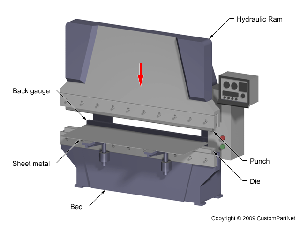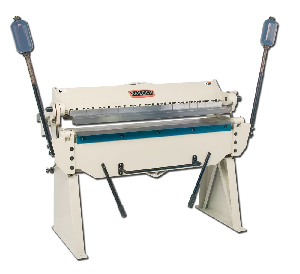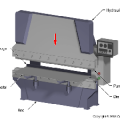 This type of machine/equipment is used to bend metal into different shapes that are then used in auto body repair shops, ventilation systems, and by installers of windows and gutters.
This type of machine/equipment is used to bend metal into different shapes that are then used in auto body repair shops, ventilation systems, and by installers of windows and gutters.
Sheet metal brake machines can be large (weighting several thousands of pounds) or you can get a portable version, which is used by many window siding installers. Although a portable sheet metal brake (commonly misspelled – sheet metal break) is not as advanced as the larger version, it is more than effective to perform basic metal shaping needs.
Different types of sheet metal brakes for sale include:
- Cornice metal breaks only allow for straight, simple metal bends to be created.
- Box & Pan Brake (also referred to as a “bending brake” or a “sheet metal folder”). The advantage that this machine has over the cornice break is that the clamping bar is broken down to several blocks that are easily removable, and can be arranged to form a variety of shapes/bends along the piece of metal. The clamping that the box and pan metal break uses can be manually or automatically operated. Once the box is formed, it is secured together by screws and rivets or welded together.
- Bar Folder brake machines are considered one of the simplest ways to bend metal. Typically, it is much smaller than the box and pan type or the cornice. The depth created by the folder sheet metal break is usually shallower than the aforementioned machines are capable.
 Press Brakes are a more complicated version of bending sheet metal, as many pre-determined shapes can be created, by having the workpiece clamped between matching punch holes.
Press Brakes are a more complicated version of bending sheet metal, as many pre-determined shapes can be created, by having the workpiece clamped between matching punch holes.
Sizes of used sheet metal brakes vary greatly, from hand-held versions made from light aluminum or brass, up to hydraulic sheet metal brake machines that are often used in large industries, to bend/shape large sheets of metal/steel quickly and effectively.
Basic components of a standard sheet metal brake:
- BED – The bed is a flat area that the piece of metal is placed on, before processing can begin.
- CLAMP PLATES are found sitting parallel to the “bed”, and holds the metal piece securely in place during the bending process.
- A BAR/BENDING PLATE is attached to the bed’s edge by hinges.
As the brake press engages, the bar hinges moves upward, and bends the metal piece that is clamped between the “plate” and the “bed”. A measurement of 120 degrees is usually the angle of the bend. Certain variables (such as the thickness of the metal) will adjust this angle.
After the metal is formed by a sheet metal brake, it can then be coated with a clear finish or finished/coated with other options, such as a white, bronze, brushed gold or black anodized for a totally new look.
New or used sheet metal brakes are made from a variety of metals, including (but not limited to) brass, aluminum and stainless steel.
Material formed by break metal machinery is used for railings, column wraps, architectural detail and framing (just to mention a few).
Sheet metal brakes and the ability to bend metal is important to many industries and homeowners. Consider that it may not be necessary for a homeowner to invest in the many options of sheet metal brakes for sale, as many large tool companies rent sheet metals breaks to homeowners, whom may only need to replace a section of aluminum siding or a gutter.
